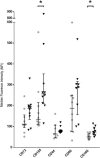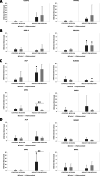MSCs from polytrauma patients: preliminary comparative study with MSCs from elective-surgery patients
- PMID: 34380565
- PMCID: PMC8356428
- DOI: 10.1186/s13287-021-02500-9
MSCs from polytrauma patients: preliminary comparative study with MSCs from elective-surgery patients
Abstract
Background: Polytrauma is a major clinical problem due to its impact on morbidity and mortality, especially among the younger population. Its pathophysiology is not completely elucidated, and the study of the involvement of certain cell populations with therapeutic potential, such as mesenchymal stromal cells (MSCs), is an area of growing interest, as mesenchymal cells have anti-inflammatory, immunoregulatory, and osteogenic potential.
Methods: In the present preliminary work, we have evaluated the characteristics of MSCs in terms of proliferation, immunophenotype, cell cycle, clonogenic capacity, and multilineage differentiation ability in a series of 18 patients with polytrauma and compared them to those from otherwise healthy patients undergoing elective spinal surgery.
Results: MSCs from polytrauma patients displayed higher proliferative potential with significantly higher cumulative population doublings, increased expression of some important cell adhesion molecules (CD105, CD166), and an early pre-osteogenic differentiation ability compared to those of the control group.
Conclusions: MSCs could potentially be of help in the repair process of polytrauma patients contribute to both cell-tissue repair and anti-inflammatory response. This potential should be further explored in larger studies.
Keywords: Bone regeneration; Cellular therapy; MSC; Mesenchymal stem cells; Mesenchymal stromal cells; Polytrauma.
© 2021. The Author(s).
Conflict of interest statement
The authors declare that they have no competing interests.
Figures




Similar articles
-
Differential expression of cell cycle and WNT pathway-related genes accounts for differences in the growth and differentiation potential of Wharton's jelly and bone marrow-derived mesenchymal stem cells.Stem Cell Res Ther. 2017 Apr 26;8(1):102. doi: 10.1186/s13287-017-0555-9. Stem Cell Res Ther. 2017. PMID: 28446235 Free PMC article.
-
Iberian pig mesenchymal stem/stromal cells from dermal skin, abdominal and subcutaneous adipose tissues, and peripheral blood: in vitro characterization and migratory properties in inflammation.Stem Cell Res Ther. 2018 Jul 4;9(1):178. doi: 10.1186/s13287-018-0933-y. Stem Cell Res Ther. 2018. PMID: 29973295 Free PMC article.
-
Effects of high glucose conditions on the expansion and differentiation capabilities of mesenchymal stromal cells derived from rat endosteal niche.BMC Mol Cell Biol. 2019 Nov 21;20(1):51. doi: 10.1186/s12860-019-0235-y. BMC Mol Cell Biol. 2019. PMID: 31752674 Free PMC article.
-
Mesenchymal stem cells: a perspective from in vitro cultures to in vivo migration and niches.Eur Cell Mater. 2010 Sep 1;20:121-33. doi: 10.22203/ecm.v020a11. Eur Cell Mater. 2010. PMID: 21249629 Review.
-
Impact of developmental origin, niche mechanics and oxygen availability on osteogenic differentiation capacity of mesenchymal stem/stromal cells.Acta Biochim Pol. 2019 Dec 29;66(4):491-498. doi: 10.18388/abp.2019_2893. Acta Biochim Pol. 2019. PMID: 31883439 Review.
Cited by
-
Therapeutic potential of mesenchymal stromal/stem cells in critical-care patients with systemic inflammatory response syndrome.Clin Transl Med. 2023 Jan;13(1):e1163. doi: 10.1002/ctm2.1163. Clin Transl Med. 2023. PMID: 36588089 Free PMC article. Review.
References
Publication types
MeSH terms
LinkOut - more resources
Full Text Sources
Research Materials

